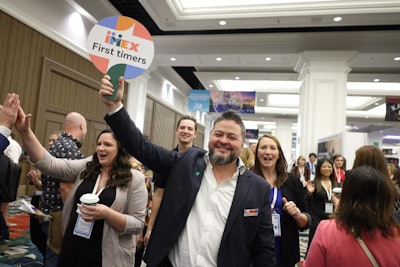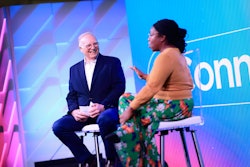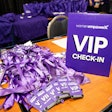
Event planners are always looking for ways to make every attendee feel welcome—especially those attending for the first time. First-timers are unique; they offer fresh perspectives and can invigorate the atmosphere of an annual event. On the flip side, it's all too easy for them to feel overwhelmed or disconnected without the right engagement strategies.
"Perhaps the hardest part of an event is convincing someone to attend in the first place; we’d much rather keep that person loyally coming back," says Lee Gimpel, the founder of consulting firm Better Meetings, who notes that new attendees bring a clear sense of excitement that planners can and should tap into. "When new people have a good experience, they tell other people outside—and that creates real energy and a pipeline to inevitably replace the old energy and the people cycling out of the field."
He adds, "It’s hard to be a sustainable event when you can’t successfully add new people and keep them." We asked Gimpel and other event and meeting professionals to share some of their best practices for engaging first-time attendees.
1. Tailor pre-event communications.
“I've seen some events have it as a checkbox at registrations where you can indicate it's your first time attending," offers MK Granados, co-founder and head of marketing for Gen City Labs. "It offers a few benefits: the opportunity to provide some tailored email communications leading into the event, as well as the option to put an indicator on their event credential that can serve as an icebreaker or flag that someone might need a little extra help navigating things.”
One large event that's adopted this strategy is IMEX America, which features an entire section for first-time attendees on its website. It offers tips for everything from setting your goals for the week, planning your schedule, navigating the show floor, and even finding a place to eat in Las Vegas.
2. Use the buddy system.
Many of the event professionals we spoke to suggested an opt-in "buddy system" that pairs seasoned attendees with first-timers. "This allows newcomers to have a go-to person for questions and guidance, fostering a sense of community and easing any potential apprehension," explains freelance event producer Dina Morales.
“Back in my association days, we used to assign a conference veteran to reach out to the first-timer prior to heading to the meeting," agrees Michele Yebba, an event planning specialist at Aspen Aerogels. "[It's] someone who can shoot them a quick email, or have a quick call and just introduce themselves. This way the first-timer knows someone at the conference.”
Sharon Reus, president of CPG Agency, adopts a similar practice, referring to the more experienced attendees as "mentors." "We suggest giving them a structured time to meet as the event kicks off, and we find these mentorships often extend long after the event," she says.
3. Acknowledge first-timers at registration.
When new attendees arrive on site, registration and welcome receptions are great places to make them feel instantly included. "We provide targeted handouts and optional badge markers that indicate they are a first-time attendee," says Jennifer Lucio Vargas, president and CEO of 305 Communications and Events. "This helps others identify who these individuals are, and be able to approach them and assist them.”
Morales also offers what she calls "personalized welcome kits or swag bags, including a customized map, schedule, and a brief note expressing excitement about their attendance. This tangible gesture helps them feel acknowledged and valued," she explains.
Heather Odendaal, founder and CEO of membership network WNORTH, uses different colored lanyards to show who’s a first-timer at the conference—but that's not all. "Our registration team celebrated first-timers at check-in with cheerleading pompoms and cheers!" she says. "It sounds cheesy, but it's really fun."
4. Give them a shout-out during welcome sessions.
“A simple mention during the program where the emcee asks all first-timers to rise and be recognized offers a nice ice-breaking moment," points out Reus.
Gimpel agrees, noting the value of shining a spotlight on some new attendees. "That might take a few different forms, but a typical one might be to ask for people who are new to volunteer to simply introduce themselves during a big session," he says. "It’s usually a quick and easy mini-interview that has them answer who they are, where they’re from, what brings them to the event, and anything they might be looking for in terms of connections, expertise, etc."
This quick moment can have lasting implications for the rest of the gathering, he adds. "That person [now] has a degree of celebrity power, and other people will easily approach him or her to say hi, offer suggestions, etc.," Gimpel explains. "Even doing that once or twice sends a signal to the rest of the attendees that new people deserve some special attention and to follow that example themselves.”
5. Consider hosting a formal first-timers tour or activity.
Many events and large conferences hold special receptions, orientations, or tours of the show floor. Morales likes to adopt strategies like exclusive first-timers' sessions—"this focused interaction allows for a more intimate introduction to the event," she notes—or even a dedicated lounge exclusively for new attendees.
Morales has also hosted interactive scavenger hunts tailored specifically for first-time attendees, "guiding them to key event features and connecting them with exhibitors or sponsors. This adds an element of fun while helping them familiarize themselves with the event," she says.
6. Give them a space to mingle with leadership.
Beyond connecting these new attendees to each other, make sure they have access to some key leaders and veteran attendees. "There's often more value in having new people meet veterans within a group rather than new people only connecting with new people," points out Gimpel. "[Mix] in some of the VIPs, such as your board or senior staff. For someone who is brand new, it's usually more exciting and helpful to have met the chair of the board and the executive director rather than meeting two other people who also have first-time badges.”
Reus has found that strategy particularly helpful when she designs and executes events for internal audiences, such as franchisee meetings and annual sales kickoffs. "We ensure there is one reception or session for newbies to interact with company leadership," she says. "A general manager from a store out in the field may not get many chances to talk with the CEO, so this first-timer reception makes them feel special and acknowledged.”
7. Lean into strategic seating arrangements.
“If you have any events where there are seating plans—like gala dinners—ensure there is a table host to ensure everyone feels welcome," suggests Odendaal. "Work with the registration team to break up cliques and ensure the newbies are spread out among the regulars.”
8. Above all, help them feel like they're a part of the community.
“I think a lot of conferences are very well-meaning when they add a first-time attendee ribbon to participants' name tags," says Gimpel. But he encourages planners to take the next step to truly welcome these new guests and integrate them into the event community. "It doesn't necessarily take much," he explains. "It could be a charge issued from the stage by the chairman of the board or someone respected within the community."
Something to keep in mind? "Often the newest people at conferences are the youngest, least experienced, and those with little power and prestige," Gimpel points out. "You don't want them to be ignored—so you do have to set a tone that the new people are valuable, important, and welcome.”



















